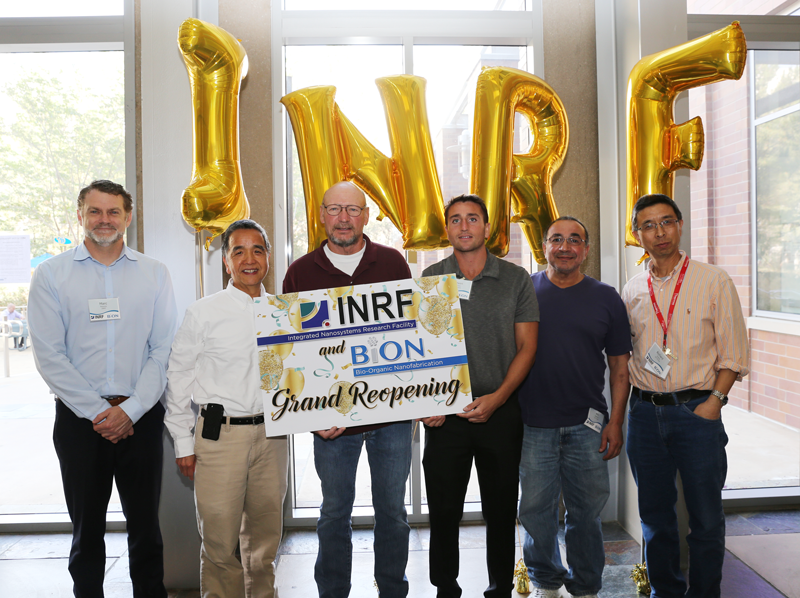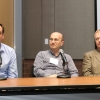Upgraded Clean Rooms Reopen
Cleanroom staff celebrate reopening, pictured from left are Marc Palazzo, G.P. Li, Jake Hes, Steven Martinez, Mo Kabili and Richard Chang.
“The campus has made major investments in INRF and BiON,” said CALIT2 Irvine Division Director G.P.Li, who welcomed the crowd that included students, faculty, researchers and industry partners, all potential users of the upgraded facilities. “We are back in business.”
Dedicated to research and development of micro- and nanodevices, the clean rooms contain tools uniquely capable of performing ultra-small-scale fabrication on materials such as polymers, hydrogels, collagens, proteins and even living tissue. The 4,000-square-foot BiON has been open continuously, but the 9,000-square-foot INRF had been closed intermittently for several years after a flooding incident.
The reopening event included staff presentations, a super-user panel discussion, equipment partner presentations, tours and a reception.
Pramod Khargonekar, UC Irvine vice chancellor for research, said, “It is facilities like INRF and BiON that are crucial for us as a research university to compete and to achieve the outcomes that solve problems and create jobs. I am so pleased to see this day.”
Li reviewed numerous improvements to the facilities including:
- An upgraded exhaust system to make laminar flows operate as they were designed to offer Class 100 work areas;
- Replacement of bad and leaky DI water valves and sterilization of the entire system to improve system performance;
- Replacement of process chilled water for comfort air and equipment cooling;
- Replacement and upgrading of the compressed air CDA (clean dry air) system that supports research equipment.
Li also noted the addition of new equipment, such as inspection microscopes for both BiON and INRF, an ADT dicing saw and a wire-bonding pull station (in collaboration with Hesse Mechatronics). He was particularly excited about the custom sensor-and-software system called Forged, which monitors and automates almost all operations. Developed by UCI alumnus Everardo Camacho in partnership with Jake Hes, who manages the two cleanrooms, the system is built on a customized programmable logic controller platform.
It monitors lab conditions, including temperature, humidity and air pressure, and chemical and equipment exhaust. It tracks air handlers, process chilled water, deionized water, chemicals, liquids and gases located inside the facility. Forged controls access to tools, schedules equipment use, and logs and analyzes usage time for each instrument. It supplies a live feed from each lab area, tracks inventory, procures supplies and automatically bills users. It compiles, analyzes and visualizes financial data. A ticket system will allow users the ability to report issues with equipment and/or the lab and receive immediate feedback and notifications of progress.
“It is part of a smart factory-of-the-future approach,” said Li.
Samueli School Dean Gregory Washington encouraged the crowd to use the upgraded clean rooms and provide feedback. “We’ve put in place the building blocks for a world-class facility. Let us know where we are missing the mark. We need your engagement.”
The super-user panel – Andrei Shkel, professor of mechanical and aerospace engineering; Ilya Krivorotov, professor of physics and astronomy; and Mark Chapman, CEO of Carbon Technology – talked about how the clean rooms have benefited their research. And representatives from three partner companies discussed the equipment and capabilities they bring to the facilities. The new wire bonding technology is a product of Hesse Mechatronics. Kyosei offers a 3-D photoetching process lab, and USHIO provides photobonding technology.
Deep discounts are offered for returning and new users during the first month of reopening. For more information, visit www.inrf.uci.edu.
– Lori Brandt

